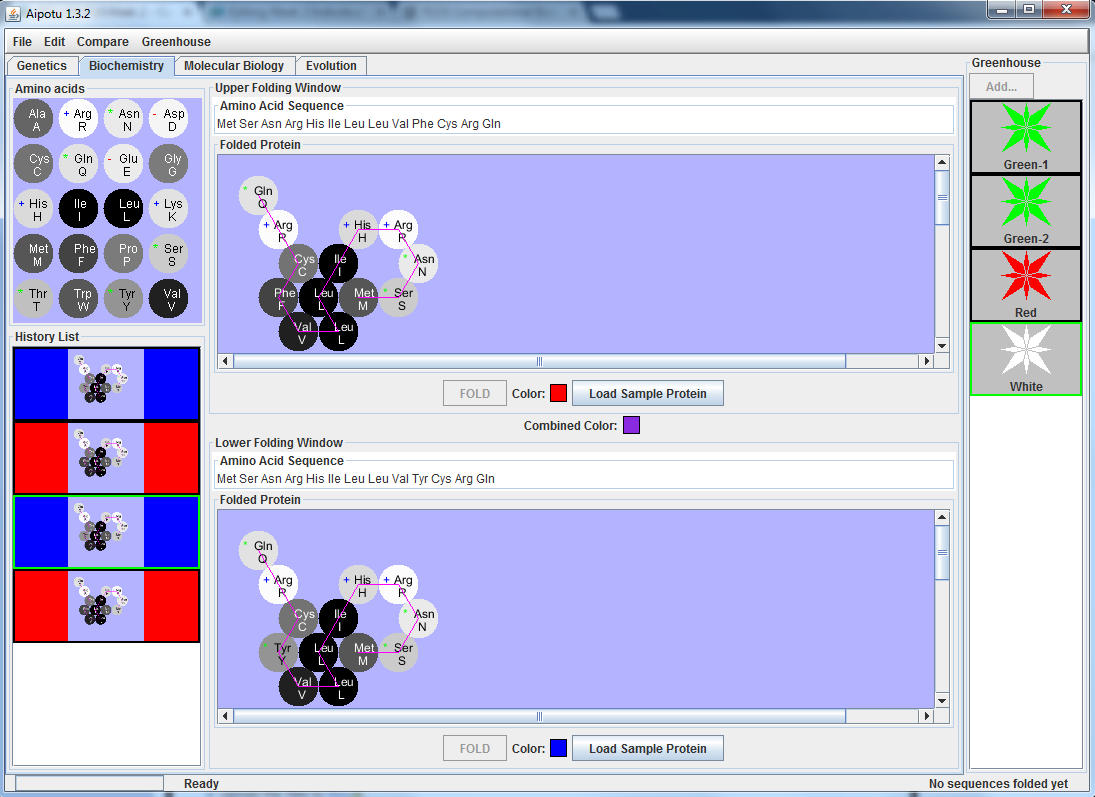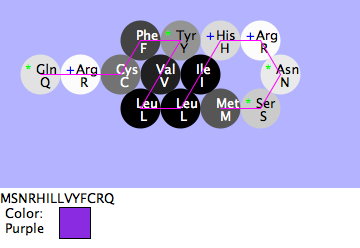Shivum Desai Journal Week 2
From OpenWetWare
Jump to navigationJump to search
Post 1
Shivum, Mia, & Will: The True Breeding Purple Flower Attempt #1
- The above image represents the two folded protein segments (Red on top and blue on bottom), and their respective amino acids, that combined to code for a true breeding purple protein.(Aipotu)
Hypothesis
- It is hypothesized that two sets of amino acids that code for the red and blue proteins will combine to code for a true breeding purple protein.
Experiment
- We constructed a 13 amino acid structure that contained 10 hydrophobic amino acids and 3 hydrophillic amino acids. The amino acids themselves, specifically the hydrophobic ones, arranged themselves in a ring formation. This is most likely due to them trying to the hydrophobic amino acids trying to reduce their surface area contact with the surrounding fluid. The result of this trial did indeed lead to a purple protein.
Result
- The resulting 14 amino acid sequence protein contained both a tyrosine and phenylanine in the position in which the two parent sequences differed. This led to the resulting combination of both tyrosine and phenylanine next to each other in the amino acid sequence that was a purple protein.
Conclusion
- Our hypothesis was proven correct. The red and blue proteins combined to produce a purple protein, but the purple protein was not true breeding.
Post 2: Successful Attempt
Shivum, Mia, & Will: The True Breeding Purple Flower Attempt #2
- This image presents the resulting true breeding purple protein that was found as a resulting of a trial and error process involving the red and blue proteins. (Aipotu)
Hypothesis
- It is hypothesized that the combination of the resulting purple protein from attempt #1, with the same purple protein will result in true breeding purple protein. Thus, true breeding purple flower.
Experiment
- This purple amino acid sequence contain 12 hydrophobic amino acids which also led to another ring like formation due to their desire to reduce surface contact with the surrounding fluid. Furthermore, due to the addition of the phenylalanine to the blue pigment sequence and tyrptophan to the red pigment sequence the only amino acid that was completely rearranged to accommodate the new formation of a sequence that included both phenylalanine and tyrptophan was valine. Regardless, this combination resulted in a purple pigment sequence.
Result
- The resulting 14 amino acid sequence was purple in color. The removal of either phenylalanine or tyrptophan would result in either a red or blue sequence. Any removal of a amino acid from there results in white.
Conclusion
- Our hypothesis was proven correct. The crossing of two purple pigment amino acid sequences led to a resulting true breeding purple protein.
Post Lab Data Questions
(A) Which Proteins are found in each of the four starting organisms?
- Green 1: The protein that codes for lime green pigmentation
- Green 2: The proteins that code for yellow and blue pigmentation
- Red: The protein that codes for red pigmentation
- White: The protein that codes for white pigmentation
(B)
- Allele Color Amino Acid Sequence
- GG___Lime green___Met Ser Asn Arg His Ile Leu Leu Val Tyr Trp Arg Gln
- BB___Blue___Met Ser Asn Arg His Ile Leu Leu Val Tyr Cys Arg Gln
- YY___Yellow___Met Ser Asn Arg His Ile Leu Leu Val Trp Cys Arg Gln
- BY___Green___Met Ser Asn Arg His Ile Leu Leu Val Trp Tyr Cys Arg Gln
- RR___Red___Met Ser Asn Arg His Ile Leu Leu Val Phe Cys Arg Gln
- WW___White___Met Ser Asn Arg His Ile Leu Leu Val Val Cys Arg Gln
- RB___Purple___Met Ser Asn Arg His Ile Leu Leu Val Tyr Phe Cys Arg Gln
(C) Which features of a protein make it colored?
- The presence of certain amino acids leads to the coloring of a protein. The addition and removal of these specific amino acids can lead to a protein having color or not having color at all. For example, Phe is red, Trp is yellow, and Tyr is blue.
(D)What features of an amino acid sequence make a protein a particular color?
- The presence of different functional groups in these amino acids give it the particular traits that lead to specific colors. These functional groups could be the presence of a hydrogen, carboxyl group, or amino group. For example, the presence of an amino group in the amino acid phenylanine leads to the color red.
(E) How do the colors combine to produce an overall color? How does this explain the genotype-phenotype rules you found in part (1)
- The colors combine via the presence of the amino acids that code for certain colors coming together in a resulting amino acid sequence. For example, the presence of Phe and Tyr in the purple protein is the reason by the amino acid sequence is purple. Because red and blue, equally expressed leads to purple. This leads to the genotypic characteristics of these amino acids. These amino acids display codominance when they are together, resulting in each allele being equally expressed leading to the blending of colors.
(F) Show your TA that you have made a purple protein. For full credit, you need to explain to your TA why it is purple
- The purple protein that my group and I created is purple due to the presence of both Phe and Tyr. Additionally, because both are being expressed in equally amounts due to codominance, this leads to the equal blending of their colors and thus the resulting purple color.
Acknowledgments
- I would like to thank Dr. Dahlquist for her help on this assignment. The website Aipotu, on which the amino acid combinations were observed and created. My group mates Mia Huddleston and Will Fuchs were also instrumental in my completion of this project. Lastly, While I worked with the people noted above, this individual journal entry was completed by me and not copied from another source. Shivum A Desai 19:35, 6 September 2016 (EDT):
References
Biochemistry. (n.d.). Retrieved September 6, 2016, from http://aipotu.umb.edu/ This website and corresponding downloaded program were used to complete this assignment

